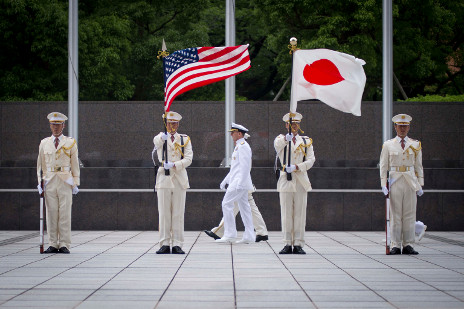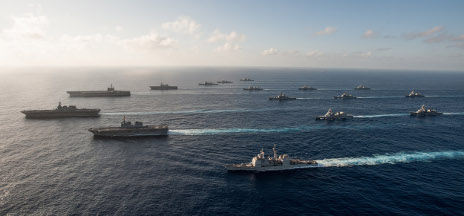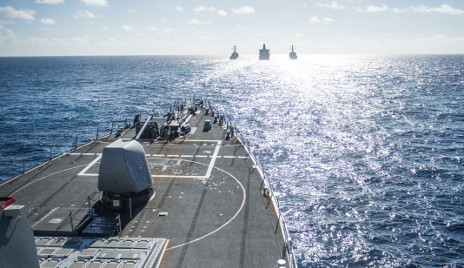
TOKYO, Japan: Chief of Naval Operations (CNO) Adm. Jonathan Greenert is escorted by a troop commander as he performs a customary troop inspection at a full honors ceremony to welcome Greenert and his delegation to Japan upon their arrival at the Japanese Ministry of Defense for a series of counterpart visits with Japanese political and military leaders. During Greenert's visit to Japan he also conducted U.S. Navy fleet engagement activities at Yokosuka Naval Base and Naval Air Facility Atsugi. (U.S. Navy photo by Chief Mass Communication Specialist Peter D. Lawlor/Released)
Japan is one of the world’s most successful democracies and largest economies. The U.S.-Japan alliance is a cornerstone of U.S. security interests in Asia and is fundamental to regional stability and prosperity. It is based on shared vital interests and values. These include stability in the Asia-Pacific region, the preservation and promotion of political and economic freedoms, support for human rights and democratic institutions, and securing of prosperity for the people of both countries and the international community as a whole.
Japan provides bases and other support to U.S. forward-deployed forces that are essential for maintaining stability in the region. Over the past decade, the alliance has been strengthened through revised defense guidelines that better define Japan's noncombatant role in a regional contingency, the renewal of the agreement on host nation support of U.S. forces forward deployed to Japan, and the Defense Policy Review Initiative (DPRI). The DPRI redefines roles, missions, and capabilities of alliance forces and outlines key realignment and transformation initiatives, including reducing the number of U.S. troops stationed in Okinawa, enhancing interoperability and communication, and broadening cooperation in the area of ballistic missile defense.
Because of the two countries' combined economic and technological impact on the world, the U.S.-Japan relationship has become global in scope. The United States and Japan cooperate on a broad range of global issues, including development assistance, combating communicable disease, and protecting the environment and natural resources. The countries also collaborate in science and technology in such areas as mapping the human genome, research on aging, and international space exploration.
Japan contributes irreplaceable political, financial, and moral support to U.S.-Japan diplomatic efforts. The United States consults closely with Japan and the Republic of Korea on policy regarding North Korea. The United States works closely with Japan and Australia under the auspices of the Trilateral Strategic Dialogue and the Security and Defense Cooperation Forum to exchange views and increase coordination on global and regional initiatives. In Southeast Asia, U.S.-Japan cooperation is vital for stability and for political and economic reform. Outside Asia, Japanese political and financial support has substantially strengthened the U.S. position on a variety of global issues, including terrorism in all its forms, working to stop the spread of epidemics, advancing environmental and climate change goals, maintaining solidarity in the face of rising challenges, assisting developing countries, countering piracy, and standing up for human rights and democracy. Japan is an indispensable partner in the United Nations. Japan broadly supports the United States on nonproliferation and nuclear issues.
The United States established diplomatic relations with Japan in 1858. During World War II, diplomatic relations between the United States and Japan were severed when both nations declared war on each other in the wake of Japan’s 1941 attack on Pearl Harbor, Hawaii. After years of fighting in the Pacific region, Japan signed an instrument of surrender in 1945. Normal diplomatic relations were reestablished in 1952, when the Supreme Commander for the Allied Powers, which had overseen the postwar Allied occupation of Japan, disbanded. The first Treaty of Mutual Cooperation and Security between the United States and Japan was signed in 1952. Relations between the two allies have been strong ever since.
Learn more at the U.S. Department of State Website

WATERS SOUTH OF JAPAN: The Ronald Reagan Carrier Strike Group (CSG) is underway in formation with Japan Maritime Self-Defense Force ships for a photo exercise during Annual Exercise 16. The Ronald Reagan CSG is participating in Annual Exercise 16 to increase interoperability between Japanese and American forces through training in air and sea operations. (U.S. Navy photo by Mass Communication Specialist 3rd Class Nathan Burke/Released)
SEVENTH Fleet’s Area of Responsibility (AOR) encompasses more than 48 million square miles (more than 124 million square kilometers) from the Kuril Islands in the north to the Antarctic in the south, and from the International Date Line to the 68th meridian east, which runs down from the India-Pakistan border. SEVENTH Fleet’s AOR includes 36 maritime countries and the world’s 5 largest foreign armed forces - People’s Republic of China, Russia, India, North Korea and Republic of Korea. Five of the seven U.S. Mutual Defense Treaties are with countries in the area - Republic of the Philippines, Australia and New Zealand, Republic of Korea, Japan, and Thailand.
U.S. presence in the region is more important than ever. U.S. naval forces help encourage dialogue, promote growth, and ensure the free flow of trade, of which the oceans have significant importance. Ninety percent of the world’s commerce travels by sea and the vast majority of the world’s population lives within a few hundred miles of the oceans, which cover nearly three quarters of the planet. Half of the world’s population lives within the SEVENTH Fleet Area of Responsibility.
To learn more, see the Commander, U.S. SEVENTH Fleet Homepage:
Or Click on any one of the following links below:
SEVENTH Fleet Overview video
Message from Commander SEVENTH Fleet VADM Thomas

EAST CHINA SEA: The Arleigh Burke-class guided missile-destroyer USS Fitzgerald (DDG 62) prepares to come alongside the Military Sealift Command underway replenishment oiler USNS Tippecanoe (T-AO-199) while it participates in a replenishment at sea with the Arleigh Burke-class guided missile-destroyer USS Curtis Wilbur (DDG 54) and the Arleigh Burke-class guided missile-destroyer USS Mustin (DDG 89). Fitzgerald is on patrol with the Ronald Reagan Carrier Strike Group in the 7th Fleet are of responsibility supporting security and stability in the Indo-Asia-Pacific region. (U.S. Navy photo by Mass Communication Specialist 3rd Class Patrick Dionne/released)
SRF-JRMC provides ship maintenance and modernization to U.S. Pacific Fleet Type Commanders using advanced industrial techniques… The command mission is, "Keep the SEVENTH Fleet Operationally Ready"
Accomplishing the SRF-JRMC Mission
SRF-JRMC Yokosuka is a full service, non-nuclear Navy-operated shipyard providing modernization, maintenance and repair to the ships of U.S. SEVENTH Fleet through depot-level maintenance availabilities (including dry dockings), Continuous Maintenance (CM), Fleet Technical Assistance (FTA), emergent repairs and voyage repairs (VR).
SRF-JRMC Detachment Sasebo is a full service Regional Maintenance Center (RMC) that primarily contracts U.S. SEVENTH Fleet ship repair work to the private sector in support of depot-level maintenance availabilities, with an in-house capability for continuous maintenance (CM), emergent repairs, voyage repairs (VR), and some Fleet Technical Assistance (FTA) in support of the ships of U.S. SEVENTH Fleet.
SRF-JRMC in Yokosuka performs and oversees modernization, maintenance and repair on USS RONALD REAGAN (CVN 76), the nation’s only forward deployed carrier, the SEVENTH Fleet Flagship, USS BLUE RIDGE (LCC 19), three (3) forward deployed Aegis guided missile cruisers (CG) and eight (8) forward deployed Aegis guided missile destroyers. Totaling 21ships including Detachment Sasebo, SRF-JRMC is responsible for 15% of the Navy’s surface fleet and partners with PSNS&IMF to maintain the forward deployed carrier.
The ships currently forward deployed to Yokosuka, Japan are:
- USS RONALD REAGAN (CVN 76)
- USS BLUE RIDGE (LCC 19)
- USS ANTIETAM (CG 54)
- USS CHANCELLORSVILLE (CG 62)
- USS SHILOH (CG 67)
- USS CURTIS WILBUR (DDG 54)
- USS JOHN S. MCCAIN (DDG 56)
- USS FITZGERALD (DDG 62)
- USS STETHEM (DDG 63)
- USS BENFOLD (DDG 65)
- USS LASSEN (DDG 82)
- USS McCAMPBELL (DDG 85)
- USS MUSTIN (DDG 89)
SRF-JRMC Yokosuka is located onboard U.S. Fleet Activities, Yokosuka (FAY) 43 miles south of Tokyo and approximately 18 miles south of Yokohama at the entrance of Tokyo Bay. FAY is the largest overseas U.S. Naval installation in the world and is considered one of the most strategically important bases in the U.S. military. Commands forward deployed to FAY include SEVENTH Fleet, Carrier Strike Group FIVE, Destroyer Squadron FIFTEEN, and Submarine Group SEVEN.
To learn more about U.S. Fleet Activities Yokosuka, (FAY), see:
SRF-JRMC Detachment Sasebo
SRF-JRMC Detachment Sasebo performs and oversees modernization, maintenance and repair on four (4) forward deployed amphibious ships, including USS BONHOMME RICHARD (LHD 6), and fours (4) forward deployed mine countermeasure ships.
The ships currently forward deployed to Sasebo, Japan are:
- USS BONHOMME RICHARD (LHD 6)
- USS GREEN BAY (LPD 20)
- USS GERMANTOWN (LSD 42)
- USS TORTUGA (LSD 46)
- USS PATRIOT (MCM 7)
- USS PIONEER (MCM 9)
- USS WARRIOR (MCM 10)
- USS CHIEF (MCM 14)
SRF-JRMC Detachment Sasebo is located onboard U.S. Fleet Activities, Sasebo (FAS) on Kyushu island, about 45 miles from the prefectural capital of Nagasaki, 78 miles from Fukuoka, largest city on the island, and about 600 miles from Tokyo. The important bilateral relationship between Japan and the United States that exists today is very evident at FAS, where ships of the Japan Maritime Self Defense Force and the United States Seventh Fleet share this excellent port. Activities forward deployed to FAS include Amphibious Group TWO Detachment, Amphibious Squadron ELEVEN, Mine Countermeasures Squadron SEVEN, and Naval Beach Unit SEVEN.
To learn more about U.S. Fleet Activities, Sasebo (FAS), see:
http://www.cnic.navy.mil/regions/cnrj/installations/cfa_sasebo.html
Ship Repair Facility and Japan Regional Maintenance Center (SRF-JRMC) Mission, Vision and Values
SRF-JRMC Mission Statement-
“KEEP THE SEVENTH FLEET OPERATIONALLY READY”
SRF-JRMC Motto-
“Nan Demo Dekimasu” – We Can Do Anything
SRF-JRMC Vision-
To be the best performing U.S. Naval Ship Maintenance Provider, we will be a model organization that:
- Is the employer of choice, known for its cooperative spirit, friendly workplace, respectful working environment, and diversity of thought, providing challenging and rewarding professional development opportunities.
- Continuously improves safety, quality, timeliness, productivity, efficiency, and environmental protection, while maintaining technical compliance.
- Possesses required capabilities, operates modern facilities, and employs state of the art technologies.
- Consistently exceeds our internal and external customers’ expectations.
SRF-JRMC Guiding Principles-
- We are dedicated to maintaining SEVENTH FLEET operational readiness by delivering first-time quality ship repair and modernization in a timely and cost efficient manner.
- We will conduct ourselves with absolute integrity.
- We will always remain vigilant to stay safe and accident free.
- We will provide a safe and harmonious working environment, which recognizes the dignity of the individual and the benefits of teamwork.
- People are our most valuable resource. We will ensure they are fully trained and equipped to carry out SRF-JRMC’s mission.
- We will continuously strive to protect our environment and its natural and cultural resources.
- We will strive to improve our products and services through unrelenting continuous improvement.
- We will keep SRF-JRMC fully loaded with work that enhances the skills and talents of our people.
- We will strive to communicate and enhance our bilingual capability and work together to improve our winning team.
To learn more about SRF-JRMC, see other sections of this website and visit the SRF-JRMC website:
https://www.srf.navy.mil/
Puget Sound and Intermediate Maintenance Facility (PSNS&IMF) Detachment, Yokosuka
We are currently refining our information in this area. Please come back again soon to check for an update.